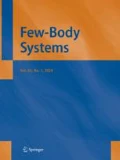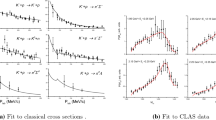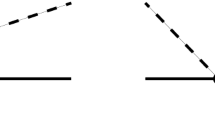Abstract
It is shown, that the energy dependence of the chiral based \(\bar{K}N\) potentials, responsible for the occurrence of two poles in the \(I=0\) sector, is the consequence of applying the on-shell factorization introduced in Oset and Ramos (Nucl Phys A 635:99, 1998). When the dynamical equation is solved without this approximation, the T-matrix has only one pole in the energy region of the \(\Lambda (1405)\) resonance.
Similar content being viewed by others
References
Y. Kamiya, K. Miyahara et al., Antikaon–nukleon interaction and \(\Lambda (1405)\) in chiral SU(3) dynamics. Nucl. Phys. A 954, 41 (2016)
V.K. Magas, E. Oset, A. Ramos, Evidence for the two-pole structure of the \(\Lambda (1405)\) resonance. Phys. Rev. Lett. 95, 052301 (2005)
Y. Akaishi, T. Yamazaki et al., Single-pole nature of \(\Lambda (1405)\) and structure of \(K^-pp\). Nucl. Phys. A 835, 67 (2010)
K. Moriya, R.A. Schumacher, CLAS collaboration, properties of \(\Lambda (1405)\) measured at CLAS. Nucl. Phys. A 835, 325 (2010)
K. Moriya et al., Measurement of the \(\Sigma \pi \) photoproduction line shapes near the \(\Lambda (1405)\). Phys. Rev. C 87, 035206 (2013)
H.Y. Lu et al., First observation of the \(\Lambda (1405)\) line shape in electroproduction. Phys. Rev. C 88, 045202 (2013)
R.A. Schumacher, K. Moriya, Isospin decomposition of the photoproduced \(\Sigma \pi \) system near the \(\Lambda (1405)\). Nucl. Phys. A 914, 51 (2013)
L. Roca, E. Oset, \(\Lambda (1405)\) poles obtained from \(\pi ^0\Sigma ^0\) photoproduction data. Phys. Rev. C 87, 055201 (2013)
M. Mai, U.-G. Meißner, Constrains on the chiral unitary \(\bar{K}N\) amplitude from \(\pi \Sigma K^+\) photopruduction data. Eur. Phys. J. A 51, 30 (2015)
M. Hassanvand, Y. Akaishi, T. Yamazaki, Clear indication of a strong \(I=0 \bar{K}N\) attraction in the \(\Lambda (1405)\)region from the CLAS photoproduction data. arXiv:1704.08571
A. Cieply, J. Smejkal, Separable potential model for \(K^-N\) interaction at low energies. Eur. Phys. J. A 43, 191 (2010)
J. Révai, N.V. Shevchenko, Isospin mixing effects in the low-energy \(\bar{K}N-\pi \Sigma \) interaction. Phys. Rev. C 79, 035202 (2009)
Y. Ikeda, H. Kamano, T. Sato, Energy dependence of \(\bar{K}N\) interaction and resonance pole of strange dibaryons. Prog. Theor. Phys. 124, 533 (2010)
N.V. Shevchenko, Three-body antikaon–nucleon systems. Few Body Syst. 58, 6 (2017)
Y. Ikeda, T. Sato, Resonance energy of the \(\bar{K}NN-\pi YN\) system. Phys. Rev. C 79, 035201 (2009)
J. Revai, Signature of the \(\Lambda (1405)\) resonance in neutron spectra from the \(K^{-}+d\) reaction. Few Body Syst. 54, 1865 (2013)
S. Ohnishi et al., Structure of the \(\Lambda (1405)\) and the \(K^-d\rightarrow \pi \Sigma n\) reaction. Phys. Rev. C 93, 025207 (2016)
S. Marri, S.Z. Kalantari, Coupled-channels Faddeev AGS calculation of \(K^-ppn\) and \(K^-ppp\) quasi-bound states. Eur. Phys. J. A 52, 282 (2016)
E. Oset, A. Ramos, Non-perturbative chiral approach to \(s\)-wave \(\bar{K}N\) interactions. Nucl. Phys. A 635, 99 (1998)
T. Hyodo, W. Weise, Effective \(\bar{K}N\) interaction based on chiral SU(3) dynamics. Phys. Rev. C 77, 035204 (2008)
N. Kaiser, P.B. Siegel, W. Weise, Chiral dynamics and the low-energy kaon–nucleon interaction. Nucl. Phys. A 594, 325 (1995)
J. Marton, M. Bazzi, SIDDHARTA results and implications of the results on antikaon–nucleon interaction. AIP Conf. Proc. 1735, 080014 (2016)
U.-G. Meißner, U. Raha, A. Rusetsky, Kaon-nucleon scattering length from kaonic deuterium experiments. Eur. Phys. J. C 47, 473 (2006)
V. Baru, E. Epelbaum, A. Rusetsky, The role of nucleon recoil in low-energy antikaon-deuteron scattering. Eur. Phys. J. A 42, 111 (2009)
Author information
Authors and Affiliations
Corresponding author
Rights and permissions
About this article
Cite this article
Révai, J. Are the Chiral Based \(\bar{\varvec{K}}\varvec{N}\) Potentials Really Energy-Dependent?. Few-Body Syst 59, 49 (2018). https://doi.org/10.1007/s00601-018-1371-1
Received:
Accepted:
Published:
DOI: https://doi.org/10.1007/s00601-018-1371-1




